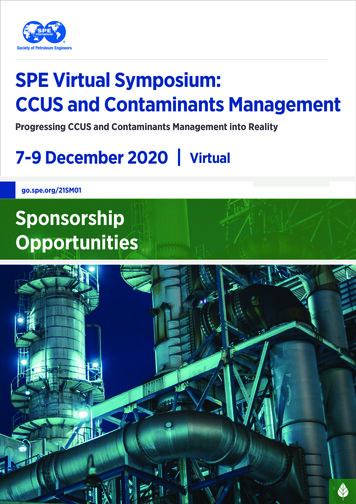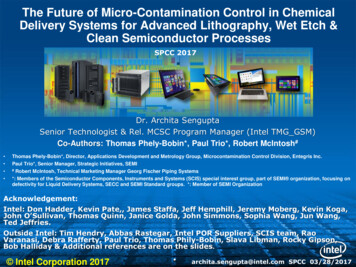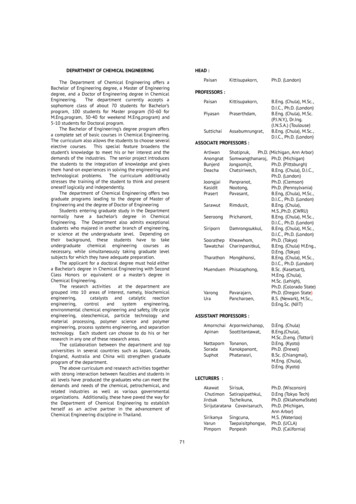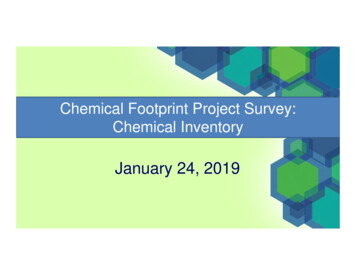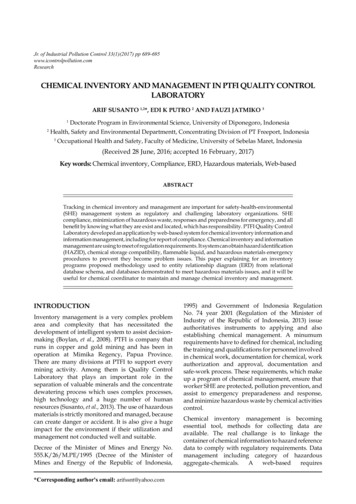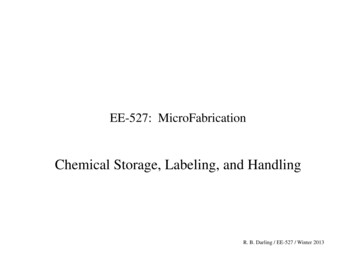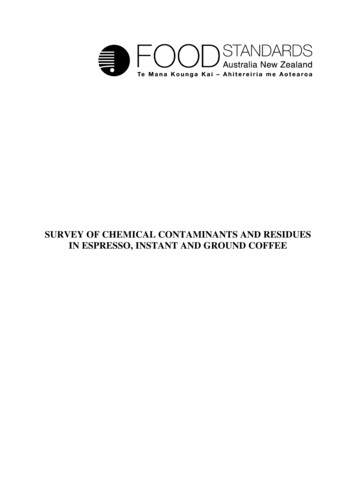
Transcription
SURVEY OF CHEMICAL CONTAMINANTS AND RESIDUESIN ESPRESSO, INSTANT AND GROUND COFFEE
SummaryThe consumption of coffee, particularly espresso coffee, has increased in Australia overtime. To update and enhance the evidence base for coffee, Food Standards Australia NewZealand (FSANZ) commissioned an analytical survey to determine the level of chemicalcontaminants and residues in coffee.This survey considered a range of chemical contaminants thought to be present in coffee.The range of chemicals analysed in this survey included metals, acrylamide, furan,polycyclic aromatic hydrocarbons (PAHs), ochratoxin A, and a range of pesticide residues.The survey analysed 41 composite samples of a variety of coffee types available from foodservice and retail outlets in Melbourne and Sydney. Coffee types considered in this surveyincluded a range of espresso coffee (cappuccino, latte, flat white, mocha, short black) aswell as instant and plunger coffee. The composite samples were all analysed on an „asconsumed‟ basis for the range of chemical contaminants identified.The key findings from this survey are:For the majority of analytes assessed, there were no detectable levelsin any of the coffee types sampled. This included all 98 pesticideresidues, 18 PAHs, beryllium, mercury and ochratoxin A.A small number of metals, furan and acrylamide were detected in someof the coffee types analysed, but at very low levels.The contribution of a number of metal contaminants to dietaryexposure through the consumption of instant and espresso coffee incomparison to the relevant reference health standard will be assessedas part of the 23rd Australian Total Diet Study (ATDS). However, it isanticipated that instant and espresso coffee are likely to be very smallcontributors to dietary exposure.For the metal contaminants analysed in this study, there are noestablished maximum levels (MLs) under Standard 1.4.1 –Contaminants and Natural Toxicants of the Code for coffee or coffeebeans. This is generally reflective of low levels of contaminants inthese products, and of coffee not being a significant contributor toexposure of these contaminants in the total diet.The overall levels of chemical contaminants identified in this survey aregenerally considered to be low and are consistent with those reportedin other comparable surveys both in Australia and overseas.This survey was undertaken as part of the surveillance program in 2008 with the intent togather analytical data only for this commodity. Given this survey only investigated coffee forthe presence of contaminants and residues, a dietary exposure assessment and comparisonto the relevant reference health standard was not conducted. In addition, data collected inthis survey was submitted to the 72nd meeting of the Joint FAO/WHO Expert Committee onFood Additives (JECFA) to inform international health risk evaluations of thesecontaminants.Page 2 of 45
AcknowledgementsFSANZ would like to thank the following organisations or people:The staff at Leeder Consulting for sample collection, sample analyses andtechnical advice.The staff at Symbio Alliance for the analysis of ochratoxin A in coffee samples.
TABLE OF CONTENTSSummary . 2Acknowledgements . 2Abbreviations . 4Introduction . 5Background. 5Objective . 6Survey design and methodology . 6Results . 9Discussion . 18Next steps . 22Conclusion . 22References . 23Appendix 1 Definitions and glossary of terms . 26Appendix 2 Mean concentration of chemicals and residues in coffee . 27LIST OF TABLESTable 1: Number of samples analysed by coffee type . 8Table 2: Comparison of the chemicals detected in various types of coffee . 17Table 3: Comparison of the concentration levels of metal and processing contaminantsfound in this survey with levels reported overseas . 18LIST OF FIGURESFigure 1: Mean concentrations of chemicals in cappuccino . 9Figure 2: Mean concentrations of chemicals in latte . 10Figure 3: Mean concentrations of chemicals in flat white . 11Figure 4: Mean concentrations of chemicals in long black coffee . 12Figure 5: Mean concentrations of chemicals in short black coffee . 13Figure 6: Mean concentrations of chemicals in mocha . 14Figure 7: Mean concentrations of chemicals in instant coffee. 15Figure 8: Mean concentrations of chemicals in ground (plunger) coffee . 16Page 3 of 45
mg/kgmg/LNZ TDSPAHsPQLµg/kgAustralian Bureau of StatisticsAustralian Total Diet StudyCodex Committee on Contaminants in FoodFood and Agricultural OrganizationFood Standards Australia New ZealandGas Chromatography Mass Spectrometry withElectron Capture DetectorGas Chromatography Mass SpectrometryHigh Resolution Gas ChromatographHigh Resolution Mass SpectrometerInductively Coupled Plasma Mass SpectrometryJoint FAO/WHO Expert Committee on FoodAdditivesLiquid Chromatography Tandem MassSpectrometryLimit of DetectionLimit of ReportingLimit of QuantificationMilligrams per kilogramMilligrams per litreNew Zealand Total Diet StudyPolycyclic Aromatic HydrocarbonsPractical Quantitation LimitMicrograms per kilogramµg/LWHOMicrograms per litreWorld Health OrganizationGC/MSHRGCHRMSICP-MSJECFALC/MS/MSNote: A glossary of terms can be found in Appendix 1Page 4 of 45
IntroductionChemical contaminants and residues can enter the food supply through environmentalfactors such as air, soil and water or through food processing factors. The levels of thesechemicals in food can vary. Some could have potential adverse health effects if consumed atlevels considered to be unsafe. In coffee, for example, a number of chemicals have beenidentified such as metals (e.g. aluminium and zinc) and contaminants such as pesticideresidues and mycotoxins (e.g. ochratoxin A). Chemical contaminants such as acrylamide,furan and PAHs have also been identified in coffee and are a result of food processing.FSANZ has previously analysed instant coffee for pesticide residues, metal contaminantsand ochratoxin A as part of the 20th Australian Total Diet Study (ATDS) (FSANZ, 2003). Thisstudy reported detections for copper and zinc. Conversely, aflatoxin, ochratoxin A and arange of pesticide residues were not detected. The Australia New Zealand Food StandardsCode (the Code), includes a number of Maximum Residue Limits (MRLs) for agriculturalresidues permitted in coffee beans in Australia under Standard 1.4.2 - Maximum ResidueLimits (Australia Only). For the metal contaminants analysed in this study, there are noestablished maximum levels (MLs) under Standard 1.4.1 – Contaminants and NaturalToxicants of the Code for coffee or coffee beans. This is consistent with international bestpractice established by the Codex Committee on Food Additives and Contaminants(CCFAC), where MLs are only set for contaminants in food where consumption of thespecific food significantly contributes to the total dietary exposure to the contaminant (WHO,1995).Given the wider range of coffee types available and the increased consumption of coffee, thecurrent survey seeks to determine the levels of the aforementioned chemicals in a broaderrange of coffee including espresso, instant and ground (plunger) coffee.BackgroundIn Australia, coffee consumption has increased from 2.4 kg per person in 1998-99 to 3 kgper person per year in 2007 (ABS, 2000, EarthTrends, 2007). It has also been documentedthat between the years 2000 to 2006, coffee consumption in Australia grew at an annual rateof 3% (ICO, 2009). BIS Shrapnel published the report Coffee in Australia 2006-2008, whichnoted that in 2006, instant coffee represented 80% of coffee sales in Australia (ACTA, 2006).The report also revealed that the food service industry (cafés and restaurants) hadexperienced a 65% increase in the number of cups of coffee consumed over a 10 yearperiod, with cappuccino being the most popular beverage sold in cafés (ACTA, 2006).Coffee is prepared from coffee beans harvested from two main plant species, the Coffeaarabica and Coffea canephora (Coffeeresearch.org, 2006). The former, commonly knownas Arabica coffee, is the predominant source of the world‟s coffee, accounting forapproximately 75-80% of worldwide production. Brazil is the major coffee producer (Leoni etal., 2000). The majority of the world‟s coffee is grown and harvested between March andOctober each year (Coffeesearch.org, 2006). Given the extensive root system of this plant,at times reaching up to 20-25km in length, it is conceivable that contaminants in the soilcould be transferred to the coffee beans during maturation or alternatively during processingprocedures (Coffeeresearch.org, 2006). Subsequently, the resulting coffee that is consumedmay contain some chemical contaminants which could be of concern if consumed at highlevels.International research on the types of chemical contaminants in coffee indicate thatacrylamide (FDA, 2006), PAHs (EC, 2002b) and furan (FDA, 2009) might be present. This isPage 5 of 45
considered to be attributed to high temperature processing, such as roasting (Bagdonaite etal., 2008; Orecchio et al., 2009; Crews & Castle, 2007). In addition, metals (Suseela et al.,2001) and pesticide residues (Jacobs & Yess, 1993) in coffee have also been reported inIndia and the United States (US). The fungal mycotoxin, ochratoxin A, has also beendetected in green coffee beans, and in roasted and instant coffee in several countries,including Germany, Japan and Spain (WHO, 2007). Acrylamide and furan were recentlyreviewed at the 72nd meeting of the JECFA in February 2010 where the Committeeconsidered both compounds to be potential genotoxic carcinogens (WHO, 2010).While some of the chemical contaminants identified in coffee are likely to be generated fromthe environment, others are produced during processing. For example, acrylamide istypically formed via a process termed the Maillard reaction, which is common to foods highin carbohydrates (Lingnert et al., 2002). This reaction occurs when a reducing sugar such asglucose is combined with an amino acid, namely asparagine, during heating at hightemperature 100 C (Lingnert et al., 2002). Acrylamide has been found to cause cancer inexperimental rodents, however, there is currently a lack of evidence to suggest that dietaryexposure to acrylamide will result in an increase in the incidence of cancer in humans(WHO, 2010).Similarly, furan, a volatile chemical, can be formed when foods are heat processed (EFSA,2009). Based on animal studies, furan has been identified as potentially carcinogenic tohumans (FDA, 2004). Reports have also suggested that PAHs in coffee can be formed in theroasting process or can result from environmental contamination of the green coffee beans(Houessou et al., 2006). PAHs are a group of chemical compounds which present a potentialsafety concern for human health, as some such as Benzo[a]pyrene are known to be highlycarcinogenic (Houessou et al., 2006). Furthermore, ochratoxin A contamination of coffee hasbeen associated with the mould species Aspergillus ochraceus and has been predominantlyidentified in coffee beans post-harvest (FAO, 2010). Ochratoxin A is known for its highlytoxic properties and is considered to be a potential human carcinogen (WHO, 2007).The existing data on the presence of these chemicals in coffee available in Australia iscurrently limited. Therefore, developing and enhancing the evidence base on the levels ofchemical contaminants and residues in instant, ground and espresso coffee types inAustralia will provide valuable input into future assessments of dietary exposure and theevaluation of any potential risks to human health for the Australian population. Furthermore,the data collected in this survey can also be used as a source of information to informinternational health risk evaluations of these contaminants.ObjectiveThe objective of the survey of chemical contaminants and residues in coffee is:To determine the analytical concentration of a range of chemical contaminants andresidues in espresso, instant and ground (plunger) coffee types.Survey design and methodologyMarket share data from the Australian Coffee Traders Association and the AustralAsianSpecialty Coffee Association were used to determine the various types of coffee availablefrom both food service and retail outlets to develop a sampling plan. The Australian Bureauof Statistics (ABS) apparent consumption of foodstuffs in Australia for data was alsoconsidered.Page 6 of 45
The chemical contaminants and residues investigated in this survey were selected based onthe following criteria:there is a lack of available Australian data;the contaminant/residue is suspected to be present in coffee;a review of the international literature identified the occurrence of thecontaminant/residue in coffee; andthe contaminant/residue has previously been identified as a potential cause forconcern for public health and safety, either in Australia or elsewhere.FSANZ developed and provided comprehensive sampling instructions to Leeder Consulting,the analytical laboratory selected to purchase, prepare and analyse coffee samples for themajority of analyses for this survey.A total of 164 samples of espresso, instant and ground (plunger) coffee were purchased inJune 2008, from various retail outlets (café‟s and major supermarkets) across metropolitanlocations in both Melbourne and Sydney (Table 1).In order to maximise the range of espresso coffee types sampled, only one purchase of eachof the six ready-to-drink coffee types was made at any individual retail outlet. Multiplepurchases of the same coffee type were collected to ensure that the volume was enough forthe purposes of analysis, although the final volume was not recorded. The types of coffeeselected for sampling were nationally available and, accordingly, were not expected to showregional variation. No samples of decaffeinated coffee were purchased as part of this survey.In relation to sample preparation of instant and plunger coffee, 2 cups were prepared by thelaboratory for each purchase. For each cup, one level teaspoon of instant coffee was addedto 220ml of boiling tap water, stirred and allowed to cool prior to analysis. Similarly, forplunger coffee, 2 cups were prepared by the laboratory. To do this, a 2 cup plunger waspreheated with hot water and then emptied. Two level dessert spoons of ground coffee wereplaced in the bottom of the plunger and 440ml of near boiling water was added. The mix wasstirred with a spoon and the plunger lid replaced. The brew was left standing for 3 minutes,after which the plunger knob was lowered until fully depressed. The coffee was then dividedinto 2 cups for analysis. For samples of instant and plunger coffee containing milk (whitecoffee), 20 ml (1 Australian metric tablespoon) was added prior to cooling and analysis.Unfortified full fat milk was used in both instant and plunger coffee. No sugar was added toany of the espresso, instant and plunger coffee samples.Samples were then composited prior to analysis. Four primary purchases of the same coffeetype (e.g. cappuccino) from the same city were composited together. A total of 133contaminants which included metals (n 14), acrylamide, furan, PAHs (n 18), ochratoxin Aand pesticide residues (n 98) were analysed in 41 composite samples of coffee (Appendix2). The number of composite samples for each coffee type analysed is provided in Table 1.Given this survey analysed coffee from retail outlets as purchased and consumed, the waterused to prepare the coffee was not tested for chemical contaminants and residues. This is alimitation of the survey, as the actual contribution of chemical contaminants, particularlymetals, from the coffee and the water, could not be delineated. In addition, of the threecomposite samples of instant coffee analysed, one composite sample containing milk wasmade up of four different brands compared to the other two composites which were identical,except for the presence or absence of milk. This is also a limitation of the survey, and careshould be exercised when comparing the first composite to the other two composites due tothe potential effects of brand variation and the presence of milk in the sample.Page 7 of 45
While this study examined a variety of coffee types, the different preparation methods forespresso, instant and ground coffee and their potential contribution to contaminant levels inthe analysed samples, was outside of the scope of this survey.Table 1: Number of samples analysed by coffee typeCoffee typeTotal number ofsamplesNo. of 0Single espresso shotand steamed milkLatte4010Single espresso shotand steamed milkFlat white328Single espresso shotand steamed milkLong black164Double espresso shotShort black82Single espresso shotMocha82Single espresso shot,steamed milk andcocoa powderInstant123Coffee powder, hotwater, with and withoutmilk82Ground coffee, hotwater, with and withoutmilk.16441Ground (plunger)Total*The volume of each coffee type sampled was not recorded, however sufficient amounts were purchased for thepurposes of the analysis.The method of analysis used for the pesticide residue screen was Gas ChromatographyMass Spectrometry with Electron Capture Detector (GC/MC/ECD). The PracticalQuantitation Limit (PQL) was set at 0.001 mg/L. The PQL is equivalent to the Limit ofQuantification (LOQ) and is reported by some laboratories instead of the LOQ.For the analysis of metals, Inductively Coupled Plasma Mass Spectrometry (ICP-MS) wasused with a PQL ranging between 0.0005 – 0.001 mg/L, dependant on the analyte.Acrylamide was determined using Liquid Chromatography Mass Spectrometry (LC/MS) witha PQL of 0.0001 mg/L. The method of analysis employed for both PAHs and furan was GasChromatography Mass Spectrometry (GC/MS) with a PQL of 0.001 mg/L.Symbio Alliance conducted the analysis of ochratoxin A using Liquid ChromatographyTandem Mass Spectrometry (LC/MS/MS) with a Limit of Reporting (LOR) of 0.005 mg/kg.Page 8 of 45
ResultsA total of 41 composite samples were analysed for 133 different contaminants. Of the 5453data points, 92% were identified as non-detects, and a remaining 8% had quantified valuesor “detection” above the PQL. There were no detections above the respective PQLs for allpesticide residues analysed in each coffee type. Similarly, there were no detections abovethe LOR for ochratoxin A ( 0.005 mg/kg) and no detections above the PQL for PAHs (0.001mg/L), beryllium ( 0.001 mg/L) and mercury ( 0.0005 mg/L). The remaining chemicals forwhich there were detections above the PQL are considered further in this report. The resultsfor coffee samples collected in Sydney and Melbourne have been combined for thepurposes of reporting. In order to calculate mean concentrations for each contaminant bycoffee type, the PQL was assigned for all results reported as nd (not detected).The mean concentrations of chemical contaminants for each coffee type are shown inFigures 1 - 8. A summary of results for all chemical contaminants and residues is providedin Appendix 2.CappuccinoFrom the ten composite samples analysed, the mean concentrations of each detectedcontaminant in cappuccino are reported in Figure 1. A total of twelve chemical contaminantswere detected above the respective PQLs in cappuccino.No detections above the PQL were reported for cadmium (PQL 0.0005 mg/L) and tin (PQL 0.001 mg/L).Figure 1: Mean concentrations of chemicals in cappuccino2.5Mean concentrations ofchemicals 0220.00890.0170.00320Chemicals** Only contaminants with detections reported above the respective PQLs have been graphed; nd PQL.ˇ Zinc is considered to be a nutrient and can be found in milk.#All results have been reported to two significant figures.Page 9 of 450.032
LatteFrom the ten composite samples analysed, the mean concentrations of each detectedcontaminant in latte are reported in Figure 2. A total of twelve chemical contaminants werealso detected above the respective PQLs.As reported for cappuccino, no detections above the PQL were reported for cadmium (PQL 0.0005 mg/L) and tin (PQL 0.001 mg/L).Figure 2: Mean concentrations of chemicals in latte2.5Mean concentrations ofchemicals 20.00730.0200.00210Chemicals** Only contaminants with reported detections above the respective PQLs have been graphed; nd PQL.ˇ Zinc is considered to be a nutrient and can be found in milk.#All results have been reported to two significant figures.Page 10 of 450.023
Flat white coffeeFrom the eight composite samples analysed, the mean concentrations of each detectedcontaminant in flat white coffee are reported in Figure 3. A total of thirteen chemicalcontaminants were detected above the respective PQLs.No detections above the PQL were reported in flat white coffee for cadmium (PQL 0.0005mg/L).Figure 3: Mean concentrations of chemicals in flat white2.5Mean concentrations ofchemicals 0180.00540.0140.00180.00150Chemicals** Only contaminants with reported detections above the respective PQLs have been graphed; nd PQL.ˇ Zinc is considered to be a nutrient and can be found in milk.#All results have been reported to two significant figures.Page 11 of 450.033
Long black coffeeFrom the four composite samples analysed, the mean concentrations of each contaminant inlong black coffee are reported in Figure 4. A total of thirteen chemical contaminants weredetected above the respective PQLs.No detections above the PQL were reported in long black coffee for cadmium (PQL 0.0005mg/L)Figure 4: Mean concentrations of chemicals in long black coffee2.5Mean concentrations ofchemicals 00250.0240.0500.00230.00360Chemicals** Only contaminants with reported detections above the respective PQLs have been graphed; nd PQL.ˇ Zinc is considered to be a nutrient and can be found in milk.#All results have been reported to two significant figures.Page 12 of 450.042
Short black coffeeFrom the two composite samples analysed, the mean concentrations of each contaminant inshort black coffee are reported in Figure 5. A total of twelve chemical contaminants weredetected above the respective PQLs.As reported for cappuccino and latte, no detections above the PQL were reported in shortblack coffee for cadmium (PQL 0.0005 mg/L) and tin (0.001 mg/L)Figure 5: Mean concentrations of chemicals in short black coffee2.52Mean concentrations ofchemicals 170.00550.0690.110.00970Chemicals** Only contaminants with reported detections above the respective PQLs have been graphed; nd PQL.ˇ Zinc is considered to be a nutrient and can be found in milk.#All results have been reported to two significant figures.Page 13 of 45
MochaFrom the two composite samples of mocha analysed, the mean concentrations of eachcontaminant are reported in Figure 6. A total of thirteen chemical contaminants weredetected above the respective PQLs. Cadmium was detected in mocha coffee with a resultof 0.0044 mg/kg.Figure 6: Mean concentrations of chemicals in mocha2.52.4Mean concentrations ofchemicals 10.0060.0330.00130Chemicals** Only contaminants with reported detections above the respective PQLs have been graphed; nd PQL.ˇ Zinc is considered to be a nutrient and can be found in milk.#All results have been reported to two significant figures.Page 14 of 450.024
Instant coffeeThree instant coffee samples were analysed for a range of chemical contaminants andpesticide residues. Of the three composites, one was instant coffee (black) without milk,whereas the remaining two composites contained milk (white).The mean concentrations of each contaminant detected in instant coffee (mean derived fromcombined values for both black and white) are reported in Figure 7. A total of elevenchemical contaminants were detected above the respective PQLs.As reported for flat white coffee and long black coffee, no detections above the PQL werereported in instant coffee for cadmium (PQL 0.0005 mg/L).In general, a comparison of instant coffee (white) and instant coffee (black) indicates thatsimilar levels of contaminants were present, which is to be expected as the proportion of milkin these samples comprised less than 10% of the prepared beverage . However, there wassome variation in the level of chromium (0.016 mg/L in black; 0.005 mg/L in white), lead(0.01 mg/L in black; 0.001mg/L in white), tin (0.07 mg/L in black; 0.001 mg/L in white) andzinc (0.042 mg/L in black; 0.18 mg/L in white).While a comparison of these samples has been made, care should be exercised as onecomposite of instant coffee (white) was made up of four different brands compared to theother two composites which were identical except for the presence or absence of milk. Thisis also a limitation of the survey due to the potential effects of brand variation and thepresence of milk in the sample.Figure 7: Mean concentrations of chemicals in instant coffee2.5Mean concentrations ofchemicals .0060.180.00210Chemicals** Only contaminants with reported detections above the respective PQLs have been graphed; nd PQL.ˇ Zinc is considered to be a nutrient and can be found in milk.#All results have been reported to two significant figures. Combined results for instant white and instant black coffee have been graphed.Page 15 of 450.13
Ground (plunger) coffeeTwo composite samples of ground coffee were analysed, one sample contained milk (white)and the other was without milk (black). The mean concentrations of each contaminantdetected in ground (plunger) coffee (mean derived from combined values for both black andwhite) are reported in Figure 8. A total of eight chemical contaminants were detected abovethe respective PQLs.No detections above the PQL were reported in ground (plunger) coffee for cadmium (PQL 0.0005 mg/L), cobalt ( 0.001 mg/L), lead ( 0.001 mg/L), nickel ( 0.001 mg/L) and tin( 0.001 mg/L).A comparison of ground coffee (white) and ground coffee (black) indicates some differences.There were variations in the level of aluminium (0.31 mg/L in black; 0.18 mg/L in white),arsenic (0.0013 mg/L in black; 0.0018 mg/L in white), zinc (0.047 mg/L in black; 0.22 mg/L inwhite) and acrylamide (0.0001 mg/L in black; 0.0029 mg/L in white).Figure 8: Mean concentrations of chemicals in ground (plunger) coffee2.5Mean concentrations ofchemicals Chemicals** Only contaminants with reported detections above the respective PQLs have been graphed; nd PQL.#All results have been reported to two significant figures.ˇ Zinc is considered to be a nutrient and can be found in milk. Combined results for ground (plunger) coffee white and ground (plunger) coffee black have beengraphed.Page 16 of 450.023
Comparison of contaminants in various coffee types sampledA comparison of the number of contaminants detected for the 8 different coffee typesanalysed indicates that flat white, long black and mocha contained the largest number ofchemical contaminants above the PQL (Table 2). In contrast, instant coffee (white and blackcombined) and ground (plunger) coffee (white and black combined) reported the lowestnumber of chemical contaminants, followed by cappuccino, latte and short black coffee.Cadmium was only detected in mocha.Table 2: Comparison of the chemicals detected in various types of coffeeContaminantDetection in the eight (8) coffee types(with detects ppuccino LatteFlatwhiteLongblackShort Mocha Instant* Groundblack(plunger)# * Includes both instant coffee with mil
Page 4 of 45 Abbreviations ABS Australian Bureau of Statistics ATDS Australian Total Diet Study CCCF Codex Committee on Contaminants in Food FAO Food and Agricultural Organization FSANZ Food Standards Australia New Zealand GC/MC/ECD Gas Chromatography Mass Spectrometry with Electron Capture Detector GC/MS Gas Chromatography Mass Spectrometry HRGC High Resolution Gas Chromatograph
